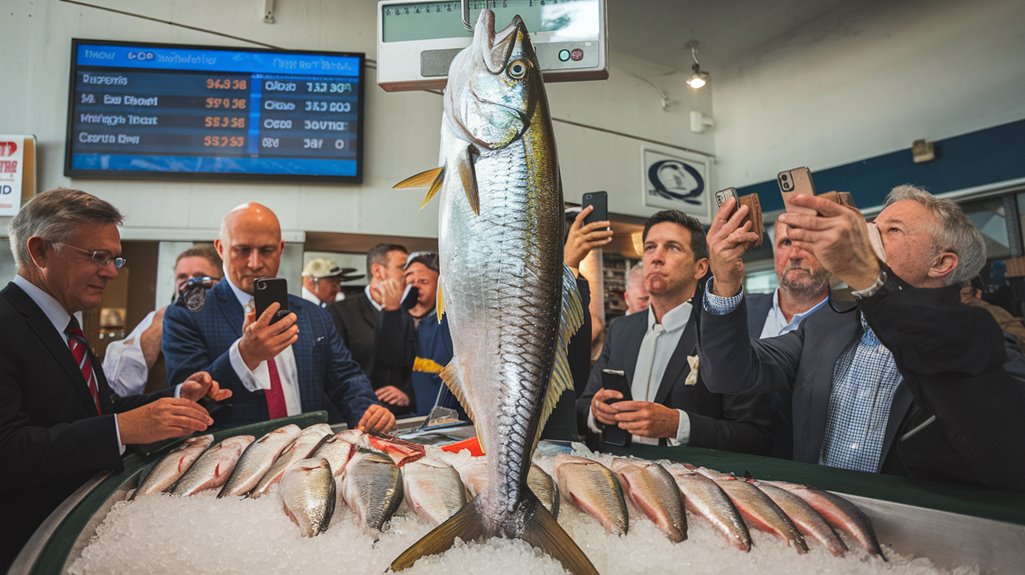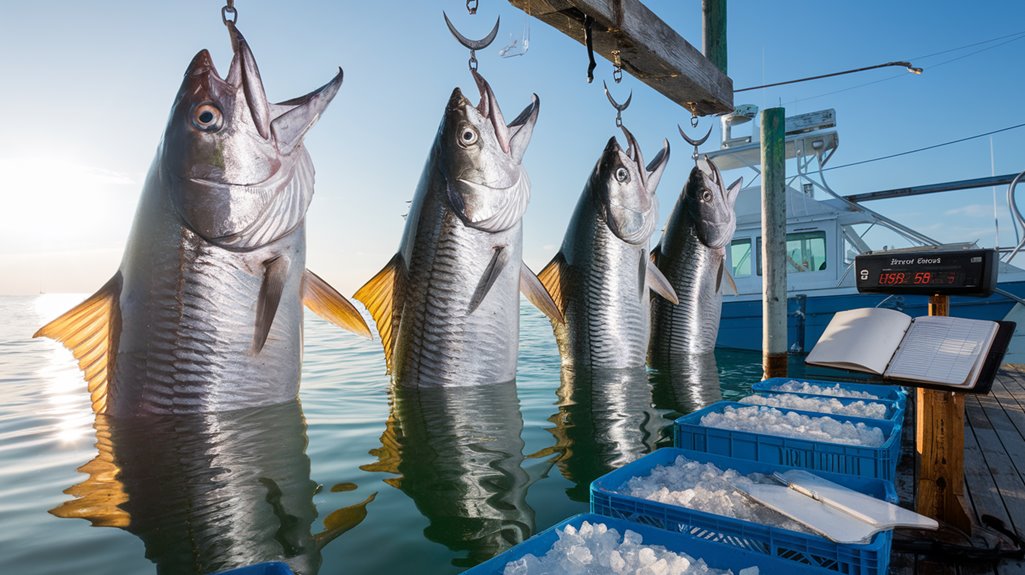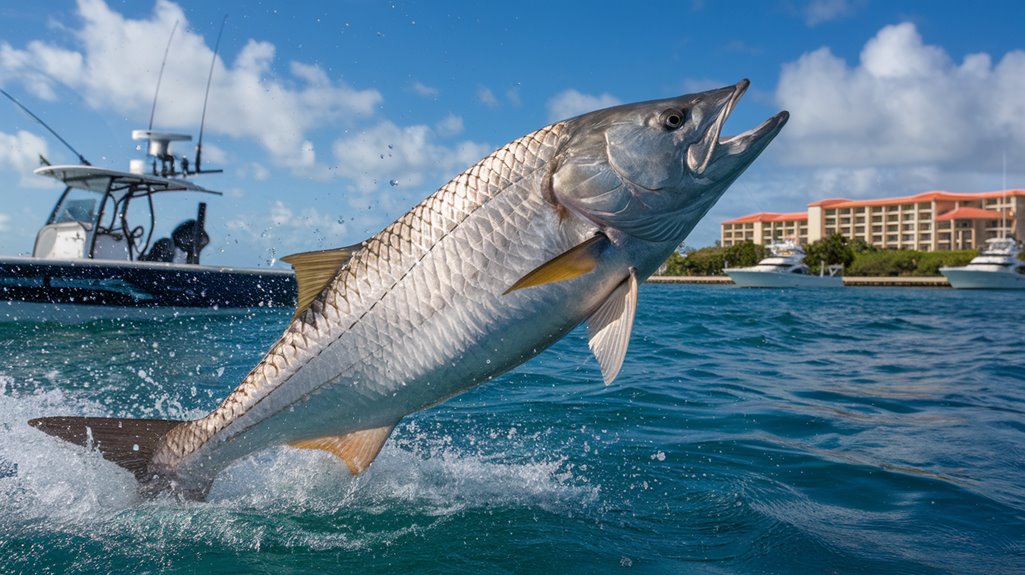When you visit Florida's Gulf Coast marinas, you'll notice a striking shift: commercial tarpon vessels have largely disappeared, replaced by charter boats catering to recreational anglers. This transformation reflects tarpon's unique market position – a fish that's generating more value alive than harvested. While its meat fetches merely $2-3 per pound, a single tarpon can contribute $1,000+ to the recreational economy through catch-and-release tourism, highlighting an evolving marine resource valuation model.
- Key Takeaways
- Economic Impact of Recreational Tarpon Fishing
- State and Private Commercial Fishery Dynamics
- Market Trends and Consumer Preferences
- Regional Distribution and Catch Statistics
- Conservation Measures and Their Market Effects
- Tourism Revenue From Sport Fishing
- Price Analysis and Market Positioning
- Seasonal Demand and Fishing Patterns
- Frequently Asked Questions
- Conclusion
Key Takeaways
- Tarpon has low commercial value as food due to poor meat quality and bony characteristics, limiting market demand.
- Recreational fishing generates significantly higher economic value than commercial sales, contributing over 689 million USD annually.
- Local market demand remains limited, particularly in Cuban communities, resulting in consistently low market prices.
- Commercial harvesting has shifted toward catch-and-release practices, prioritizing conservation and recreational value over food markets.
- Tourism-driven sport fishing dominates tarpon's economic value through guided experiences, tournaments, and related service industries.
Economic Impact of Recreational Tarpon Fishing
While tarpon may not grace dinner plates, its economic impact through recreational fishing has created a thriving industry worth over 689 million USD annually. You'll find that catch and release practices have transformed tarpon into a valuable recreational asset, driving significant revenue through guided fishing experiences and tourism.
The species' low commercial value as food has actually enhanced its economic potential in the sport fishing sector. You can see this trend particularly in destinations like Cuba, where recreational fishing tourism generates substantial income for local communities. The removal of harvest allowances has further strengthened tarpon's position in the recreational market, creating a sustainable economic model that benefits fishing guides, tourism operators, and coastal economies while preserving the species for future generations.
State and Private Commercial Fishery Dynamics
You'll find that Cuba's state-operated and private commercial fisheries maintain active tarpon operations despite the species' low market value and poor consumer reception due to its bony nature. While catch data from 42 Cuban fishing ports reveals varying yields between state and private sectors, both have experienced declining capture rates from 2016 to 2017. The downward trend in commercial catches suggests potential overfishing concerns, highlighting the need for improved management strategies across both state and private fishing operations.
State-Operated Fishing Operations
State-operated fishing operations dominate Cuba's Atlantic Tarpon industry, alongside private commercial ventures that operate with more restricted methods. You'll find that state fisheries remarkably impact population dynamics, despite the fish's low meat quality rating and limited market value.
Data from 42 fishing ports reveals a concerning decline in Atlantic Tarpon captures between 2016 and 2017. While private fishers are restricted to hook and line techniques, state-operated vessels employ more intensive commercial fishing methods. This disparity in fishing capacity has raised sustainability concerns, particularly as many vessels operate without formal state contracts.
The commercial exploitation continues even though Atlantic Tarpon's market value remains low due to its bony nature and unfavorable taste, creating an imbalance between economic returns and resource sustainability.
Private Sector Catch Patterns
Although private sector fishers operate under stricter methodological constraints than state vessels, they represent a significant portion of Cuba's Atlantic Tarpon industry. You'll find that more than half of Cuba's fishing boats operate independently from state contracts, relying exclusively on hook and line techniques for Tarpon fishing.
The commercial fisheries data reveals a concerning trend: catch yields are declining across private operations, mirroring the challenges faced in state-run sectors. While private fishers maintain consistent participation in Tarpon fishing, they're confronting limited market demand due to the species' bony nature and less-preferred taste profile. This market reality is reflected in lower prices compared to alternative fish species, affecting the economic viability of private sector operations despite their significant presence in Cuba's fishing industry.
Market Trends and Consumer Preferences

You'll find Atlantic Tarpon commanding lower market prices compared to other fish species, primarily due to its poor meat quality and bony characteristics that limit its appeal for consumption. The species' real economic value lies in recreational fishing, generating over 689 million USD annually through tourism and sport-fishing activities rather than commercial sales. While regional markets show varying demand patterns, there's a clear shift away from commercial harvesting toward catch-and-release practices, reflecting both conservation priorities and consumer preferences in the recreational sector.
Price Point Variations
Market analysis of Atlantic Tarpon reveals significant price point disparities driven by its limited culinary appeal and evolving consumer preferences. You'll find commercial fisheries struggling with consistently low market prices, while the recreational fishing sector generates substantially higher economic value.
| Market Segment | Value Indicators |
|---|---|
| Commercial Sale | Low price point |
| Sport Fishing | High revenue potential |
| Local Consumption | Limited demand |
| Tourism Impact | Premium pricing |
The market dynamics showcase a clear shift away from traditional commercial fishing toward recreational value. While state fisheries maintain some commercial operations, you're seeing diminishing returns due to the species' poor reputation as table fare. The price points in Cuba's markets remain particularly low, especially when compared to other fish species. However, the recreational sector's 689 million USD annual contribution demonstrates where the true economic value lies.
Consumption Pattern Shifts
Since the early 2000s, consumption patterns for Atlantic Tarpon have shifted dramatically from traditional food markets to recreational sport fishing. You'll find that the species' low market value, due to its bony nature and less desirable taste, has reshaped its economic significance in Cuban waters and beyond.
The implementation of catch-and-release practices, especially in federal waters, has transformed how you'll interact with this species. While traditional consumption has declined, the tarpon tag system and recreational fishing regulations have created a thriving sport fishing industry worth over 689 million USD annually. You're now more likely to encounter Atlantic Tarpon in tourist destinations promoting catch-and-release programs rather than in local markets, reflecting a fundamental shift from consumption to conservation-minded sport fishing practices.
Regional Demand Differences
While traditional seafood markets show minimal interest in Atlantic Tarpon, the species has carved out distinct regional niches based on its recreational value. You'll find that in Cuba, where local consumption remains low due to the fish's bony nature and unremarkable taste, the species commands considerably lower prices compared to other fish species.
The federal management of Tarpon as a vulnerable resource has shaped regional market dynamics, with catch-and-release practices dominating the commercial landscape. This shift is particularly evident in Cuban tourist destinations, where recreational fishing generates substantial revenue. The region's sport fishing industry, valued at over 689 million USD annually, demonstrates how market demand varies geographically, with some areas capitalizing on Tarpon's recreational appeal rather than its culinary potential.
Regional Distribution and Catch Statistics

Throughout Cuba's extensive network of 42 fishing ports, Atlantic Tarpon harvests demonstrate significant regional variations and a concerning downward trend in catch volumes. You'll find this migratory species distributed across diverse Cuban ecoregions, with catch data revealing complex patterns similar to those observed in major fishing grounds like Boca Grande.
Despite the Atlantic Tarpon's widespread presence in marine fisheries, its commercial value remains relatively low due to poor meat quality ratings. However, the species' economic impact is substantial through recreational fishing, generating over 689 million USD annually. Current regulations reflect conservation efforts, including a minimum harvest size of 430 mm fork length and catch-and-release requirements. These measures aim to protect the species while balancing the economic benefits of sport fishing with sustainable population management.
Conservation Measures and Their Market Effects
As conservation measures reshape tarpon fisheries, you'll notice distinct market effects emerging from regulatory changes. The implementation of catch-and-release regulations and the 430 mm fork length minimum size limit have reduced direct market availability, shifting the species' economic value toward recreational fishing opportunities. While these conservation measures limit harvest potential, they're driving a more lucrative sport-fishing industry, now generating over 689 million USD annually.
You'll find that despite tarpon's low meat quality and bony characteristics in Cuban markets, the species' economic impact has actually increased through tourism and recreational fishing. The elimination of harvest permits, except for record purposes, demonstrates how conservation measures are transforming tarpon's market value from a consumption commodity to a sustainable recreational resource.
Tourism Revenue From Sport Fishing
Since tarpon fishing emerged as a premier sport-fishing attraction, it's generated substantial tourism revenue across Cuban destinations, with the industry now exceeding 689 million USD annually. You'll find catch-and-release programs driving this economic success, creating a sustainable model that preserves the resource while maximizing financial returns.
The tarpon fishing market has spawned a robust service ecosystem, including specialized guides, lodging facilities, and equipment rental operations. You're seeing tournament events amplify these economic benefits by drawing international participants and spectators, while stimulating local business growth. This multi-faceted revenue stream demonstrates how sport fishing tourism can effectively balance conservation with profit generation, positioning tarpon as a valuable asset in the sustainable tourism sector.
Price Analysis and Market Positioning
The market positioning of tarpon reveals a stark contrast between its commercial and recreational value streams. You'll find that while its commercial value remains low due to poor meat quality and limited market demand, its recreational fishing sector generates substantial economic benefits.
This disparity is evident in three key market indicators:
- Low market prices compared to other commercial fish species
- Limited local market demand, particularly in Cuban communities
- High recreational value, generating $689 million annually through sport fishing
The implementation of catch and release regulations further reinforces tarpon's positioning as a premium sport fish rather than a commercial species. You'll notice this market dynamic has shifted the economic focus from traditional fishing yields to recreational fishing opportunities, establishing a more sustainable and profitable business model.
Seasonal Demand and Fishing Patterns
While commercial demand for tarpon remains consistently low throughout the year, seasonal patterns strongly influence fishing activities and market dynamics. You'll notice peak fishing effort during warmer months in the Gulf of Mexico, particularly in Cuban waters where commercial operations target these fish despite their limited market appeal.
| Season | Fishing Effort | Primary Activity |
|---|---|---|
| Spring | High | Tourist catch-and-release |
| Summer | Peak | Commercial fishing |
| Fall | Moderate | Mixed usage |
| Winter | Low | Limited operations |
The data from 42 Cuban fishing ports reveals significant variations in seasonal catch rates, yet the species' poor eating qualities continue to suppress market demand. You'll find that tourism-driven recreational fishing has become the dominant economic driver, with catch-and-release practices gaining prominence over extractive commercial fishing.
Frequently Asked Questions
Where Is the Tarpon Fishing Capital of the World?
You'll find the world's tarpon fishing capital in Boca Grande Pass, Florida, where deep waters and strong tides create prime fishing conditions, attracting global anglers for prestigious tournaments year-round.
How Old Is a 100 Pound Tarpon?
While some Tarpon grow faster in favorable conditions, you'll typically find a 100-pound Tarpon to be 7-10 years old, based on their average growth rate of 10-15 pounds annually.
Why Is Tarpon Fishing so Popular?
You'll find tarpon fishing's popularity stems from their spectacular aerial displays and fighting strength. The sport generates over 689 million USD annually in Cuba while promoting sustainable catch-and-release practices.
Is Tarpon Endangered?
While tarpon isn't officially endangered worldwide, you'll find they're classified as vulnerable in Cuban waters. Their populations face significant pressure from overfishing, habitat loss, and bycatch, requiring active conservation measures.
Conclusion
You'll find that tarpon's true value isn't in its meat but in its mighty leaps – like silver kings vaulting towards profits. The shift from commercial harvest to catch-and-release has transformed this resource into a $689 million recreational powerhouse. As market trends continue evolving, you're witnessing a sustainable model where conservation and economic growth swim together, creating rippling effects across coastal economies.

